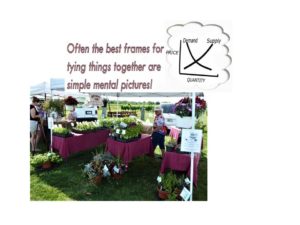Skip to content
by David W Brown Middletown RI March 2023
We applied economists like to frame people. It drives us nuts to have long meandering discourses or polarizing debates, with no way to sort out the more relevant from the less relevant, and to tie things together.
But many economists in turn drive people nuts by talking high in the esoteric clouds, often using math-laden models. Why not start with real-world problems, realities, and possibilities? Then reach up to see what theory, methodologies, and previous research have to offer? And mesh together, apply, and explain with straightforward visuals and examples?
Here are short write-ups and visuals that have helped in my teaching, in-service training, and advisory roles. They reflect my work with interdisciplinary-minded groups in the U.S. and abroad.
Also, I’m doing write-ups about new diagnostic frames likely to be useful for coming to grips with issues, opportunities, and choices in our surroundings these days.
Let me know (email djbrown2d@yahoo.com), and I’ll be glad to adapt these and other materials to your special needs and interests.
Highlighted
Via the Economics in Context initiative, a team with Boston U and Tufts is showing how meaningful economics analysis goes beyond markets and profits to show how key entities can help human wellbeing in sustained ways.
Ryan Law’s Persuasive Writing in Three Steps: Thesis, Antithesis, Synthesis I was introduced to this approach by my PhD land economics mentor at Iowa State U, John Timmons. Over the decades it has been a big help for coming to grips with issues. Delighted to see this fresh modern-day adaptation!
Kate Raworth’s Doughnut Economics Highlights outer ecological limits and inner bounds of human needs. She is reaching out to students with animations, and incorporating their fresh ideas.
Whitehead’s Rhythm of Education romance > precision > generalization Written a long time ago, but still useful for students as well as teachers.
Farm economic planning My compilation of budgeting and other practical tools that new-era farm families and their advisers can use to help avoid costly mistakes.
Very useful too



